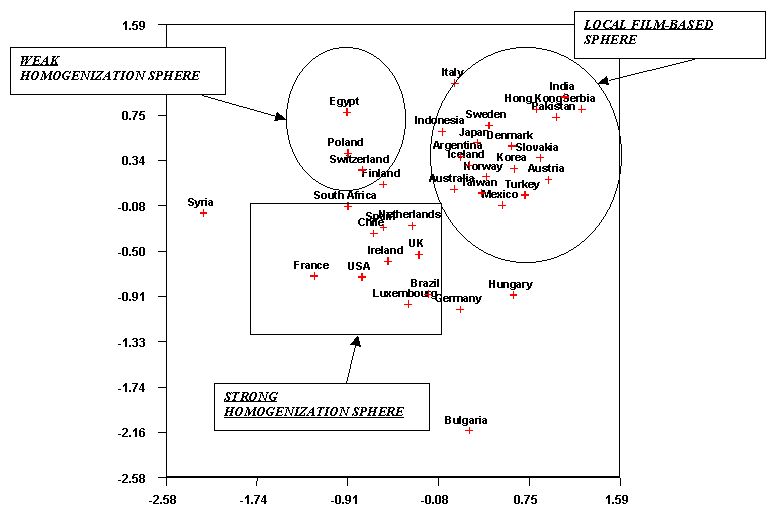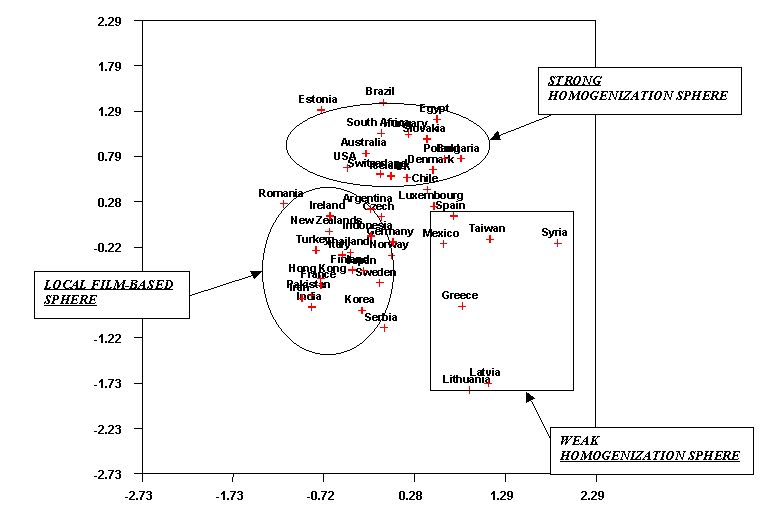
Bum Soo Chon, George Barnett and Young Choi
(2003) 'Clustering Local Tastes in Global Culture: The Reception Structure of Hollywood
Films'
Sociological Research Online, vol. 8, no. 1,
<http://www.socresonline.org.uk/8/1/chon.html>
To cite articles published in Sociological Research Online, please reference the above information and include paragraph numbers if necessary
Received: 3/10/2002 Accepted: 26/2/2003 Published: 28/2/2003
 Abstract
Abstract Introduction
Introduction Theory
Theory Method
Method Results
Results
Table 1: The top 10 Films by Bonacich Eigenvector Centralities
| Ranking | 1998 | 1995 | 1993 |
| 1 | Local Movies | Local Movies | Local Movies |
| 2 | Titanic | Die Hard 3 | Jurassic Park |
| 3 | Armageddon | Batman Forever | The Bodyguard |
| 4 | Saving Private Ryan | Forrest Gump | Cliffhanger |
| 5 | Godzilla | Casper | The Fugitive |
| 6 | As Good As It Gets | Pochahontas | Indecent Proposal |
| 7 | Deep Impact | Waterworld | Aladdin |
| 8 | There's Something about Mary | Apollo 13 | Home Alone 2 |
| 9 | Mulan | Dumb and Dummer | Hot Shots |
| 10 | Tomorrow Never Die | The Lion King | The Firm |
Table 2: Hierarchies of Bonacich Eigenvector Centralities for Countries Over Time
| Year | Higher Group: More Local Films | Middle Group:
Partly Local Films | Lower Group: Mainly Hollywood Films |
1993 | India, Hong Kong, Pakistan, Serbia, Japan, Denmark, Sweden, Iceland, Norway, Mexico, Korea, Argentina | Slovakia, Australia, Taiwan, Turkey, Indonesia, Australia, Netherlands, Spain, Chile, UK, Finland, Ireland, Switzerland | USA, Poland, Egypt, South Africa, Brazil, Hungary, Luxembourg, Germany, France, Bulgaria, Syria |
1995 | Pakistan, Hong Kong, France, India, Iran, Thailand, Sweden, Japan, New Zealand, Finland, Korea | Italy, Serbia, Argentina, Indonesia, Czech, Germany, Ireland, Norway, Turkey, Romania, Iceland, UK, Mexico | USA, Australia, Chile, Denmark, Luxembourg, Switzerland, Hungary, Slovakia, South Africa, Bulgaria, Spain, Poland, Brazil, Egypt, Greece, Taiwan, Estonia, Latvia, Lithuania, Syria |
1998 | Iran, Pakistan, India, Egypt, Serbia, Sweden, Poland, Korea, France, Turkey, Hong Kong, Japan | Ireland, Argentina, UK, Denmark, Czech, Spain, Norway, Austria, Singapore, Netherlands, Latvia, Indonesia, Greece, Italy, Germany, New Zealand, Belgium, Iceland, Slovakia, Switzerland | USA, Brazil, Chile, South Africa, Australia, Venezuela, Thailand, Mexico, Estonia, Lithuania, Bulgaria, Romania |

|
| Figure 1. Multidimensional Scaling of International Film in 1993 |

Figure 2. Multidimensional Scaling of International Film in 1995

|
| Figure 3. Multidimensional Scaling of International Film in 1998 |
| Table 4: QAP correlations among 1993, 1995 and 1998 | |||
| Year | 1993 | 1995 | 1998 |
| 1993 | 1.0 | ||
| 1995 | 0.576 | 1.0 | |
| 1998 | 0.442 | 0.416 | 1.0 |
* All correlations are significant beyond the 0.001 level. | |||
| Table 5: QAP correlations among variables | ||||
| Film | Language | Zone | Bloc | |
| Film | 1.0 | |||
| Language Similarity | 0.001 (0.478) | 1.0 | ||
| Cultural Zone | 0.161 (0.002) | 0.102 (0.021) | 1.0 | |
| Trade Bloc | -
0.005 (0.510) | 0.185 (0.001) | 0.112 (0.021) | 1.0 |
 Discussion
Discussion
 Notes
Notes
2 The sample sizes for this analysis: N = 44 for the QAP correlations. Those countries are Argentina, Australia, Austria, Belgium, Brazil, Bulgaria, Chile, Czech, Denmark, Egypt, Estonia, France, Germany, Greece, Hong Kong, Iceland, India, Indonesia, Iran, Ireland, Italy, Japan, Latvia, Lithuania, Mexico, Netherlands, New Zealand, Norway, Pakistan, Poland, Romania, Serbia, Singapore, Slovakia, South Africa, Korea, Spain, Sweden, Switzerland, Thailand, Turkey, U.K., U.S. and Venezuela.
APPADURAI,A. (1990). Disjuncture and difference in the global cultural economy. Public Culture, 2, 2, 1-24.
BARNETT,G. A. (2001). A longitudinal analysis of the international telecommunication network, 1978-1996. American Behavioral Scientist, 44, 10, 1638- 1655.
BARNETT, G. A., & CHOI, Y. (1995). Physical distance and language as determinants of the international telecommunications network. International Political Science Review, 16, 249-265.
BARNETT, G. A. & DANOWSKI, J. A. (1992). The structure of communication: A network analysis of the International Communication Association. Human Communication Research,19, 2, 264-285.
BARNETT, G.A., & WOELFEL, J. (Eds.)(1988). Readings in the Galileo System: Theory, methods and applications. Dubuque, IA: Kendall/Hunt.
BARNETT, G. A., DANOWSKI, J. A., RICHARDS, W. D., Jr. (1993). Communication networks and network analysis: A current assessment, in W. D. Richards & G.A. Barnett (eds.), Progress in Communication Sciences 12 (pp.1-19). Norwood, NJ: Ablex.
BARNETT, G.A., SALISBURY, J.G.T., KIM, C., & LANGHORNE, A. (1999). Globalization and international communication: An examination of monetary, telecommunications, and trade networks. The Journal of International Communication, 6, 2, 7-49.
BOLI, J. & THOMAS, G.M. (1997). World culture in the world polity: A century of international non-governmental organization. American Sociological Review,62, 171-190.
BONACICH,P. (1987). Power and centrality: A family of measures. American Journal of Sociology,92, 1170-1182.
BORGATTI, S., EVERETT, M., & FREEMAN, L. (1999). UCINET 5.0: Network Analysis Software. Columbia, SC: Analytic Technologies.
BOYD-BARRETT,O. (1977). Media Imperialism: Toward an International Framework for the Analysis of Media Systems (pp.116-135) In J. Curran, M. Gurevitch, & J. Woollacott (eds.). Mass Communication and Society.Beverly Hills, CA: Sage.
CHOI, J. H. & DANOWSKI, J. (2002). Cultural communities on the net - Global village or global metropolis?: A network analysis of Usenet newsgroups. Journal of Computer-Mediated Communication,7:3. Available: http://www.a scusc.org/jcmc/vol7/issue3/choi.html.
FREEMAN,L. C. (1979). Centrality in Social Networks: Conceptual Clarification. Social Networks,1, 215-239.
GUBACK,T. (1987). The evolution of motion picture business in the 1980s. Journal of Communication, 37, 2, 60-77.
HAN,C. (1998). The structure and implications of the international film flow from 1976 to 1993. Master thesis. Buffalo: State University of New York.
HENDERSON, E. A. & TUCKER, R. (2001). Clear and present strangers: The clash of civilizations and international conflict. International Studies Quarterly, 45, 2, 317- 338.
HERMAN, E.S. & MCCHESNEY, R.W. (1997). The global media: The new missionaries of corporate capitalism.
HOLTON,R. (2000). Globalization's cultural consequences. Annals of the American Academy of Political and Social Science,570, 140-152.
HUNTINGTON, S. (1996). The Clash of Civilizations and the Remaking of World Order. New York: Simon and Schuster.
HYUN, K. J. (2001). Sociocultural change and traditional values: Confucian values among Koreans and Korean Americans. International Journal of Intercultural Relations, 25, 203-229.
INGLEHART, R. & CARBALLO, M. (1997). Does Latin America exist? (And is there a Confucian culture?): A global analysis of cross-cultural differences. Political Science & Politics, 30, 1, 34-47.
INGLEHART, R. & BAKER, W. E. (2000). Modernization, cultural change, and the persistence of traditional values. American Sociological Review; 65, 1, 19-51.
INGLEHART, R. & BAKER, W. E. (2001).
Modernization's challenge to traditional values:
Who's afraid of Ronald McDonald? The Futurist, 35, 2, 16-21.
KRACKHARDT,D. (1987). QAP Partialling as a
Test for Spuriousness. Social Networks, 9,
171-86.
MATTELART,A. (1979). Multinational
corporations and the control of culture.Brighton:
Harvester Press.
MOWLANA, H. M. (1996). Global
communication in transition.Thousand Oaks, CA: Sage.
OLSON, S.R. (1999). Hollywood planet: Global
media and the competitive advantage of
narrative transparency.New Jersey: LEA.
PARK,H. (1998). A Gramscian approach to
interpreting international communication.
Journal of Communication,48, 4, 79-99.
ROKEACH,M. (1972). Beliefs, Attitudes, and
Values: A Theory of Organization and
Change. Jossey-Bass: San Francisco.
ROGERS, E.M., & KINCAID, D.L. (1981).
Communication networks: Toward a new paradigm for research. New York:
Free Press.
STRAUBHAAR, J. D. (1997). Distinguishing the
global, regional and national levels of world
television. In Sreberny-Mohammadi, A., Winseck, D., McKenna, J and Boyd-
Barret
(pp. 284-298) Media in global context: A reader.New York: Arnold.
Variety (1995, 1998, 2000). Variety International Film Guide. London : Andre
Deutsch.
VARIS,T. (1985). International Flow of Television
Programmes.Paris: UNESCO.
VOGEL,H. L. (1998). Entertainment industry
economics : a guide for financial analysis.
4th ed. Cambridge : Cambridge University Press.
WATERS,M. (1995). Globalization.London:
Routledge.
WELLMAN, B. (1988). Structural analysis: From
method and metaphor to theory and
substance. In B. Wellman & S. D. Berkowitz (Eds.), Social Structures: A
Network
Approach (pp.19-61). New York: Cambridge University Press.
WOELFEL, J., & FINK, E. L. (1980). The
measurement of communication processes: Galileo
theory and method.New York: Academic.
YOUNG,F. W. (1987). Multidimensional scaling :
history, theory, and applications.Hillsdale, N.J.: L. Erlbaum Associates.